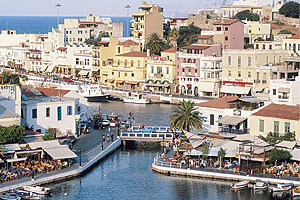Crete is located on the eastern side of the Mediterranean Sea, set between Africa, Asia Minor and Europe. It is the largest of the Greek islands and the fifth in size of all Mediterranean islands. It has a surface area of 8,331 km² and a coastline 1,000 km in length. It is part of Greece (which is 100 km away) and its capital is Heraklion also known as Candia. Its population is currently around 600,000 inhabitants.
The civilization which flourished in this remote region between 3,000 and 1,200 B.C. is called Minoan and was a precursor of the Greek Civilization. Many imposing palaces are left as proof of its existence, although some mysteries remain regarding its people’s customs, origins and, above all, the cause of their decline, which has been attributed as much to natural disasters as to the invasion of another contemporary culture: The Micenic Culture.
Economy and Administration.
Agriculture is Crete’s main economic resource, despite the small area set aside for this purpose and the need to use traditional techniques due to the ruggedness of the land that hinders the use of modern agricultural machinery. Although olives are the most important product, cereals, citrus, vegetables are also grown alongside vineyards and orchards.
Tourism is another important industry for the Cretan economy, mainly because the island offers visitors pleasant weather, attractive landscapes and valuable archeological sites such as the many palaces from the Minoan period scattered throughout Crete. Among them the most renown are, Knossos, Phaistos, Mallia and Zakros. Furthermore, the Dorians, Mycenaeans, Greeks, Romans, Sarecens, Byzantines, Venetians and Ottomans all left numerous ruins marking their presence on the island, thus giving it a multi-cultural appeal. This is reflected in the varied and beautiful work of local artisans in basket weaving, metals and ceramics. They also have vast tourist complexes like the one in Agios Nikolaos, especially on the northern part of the island.
Stockbreeding, mainly goats and sheep, is on a small scale, as well as food related industrial activity, which is concentrated in the outskirts of the capital.
For administrative purposes, Crete is a region of Greece, divided into four prefectures or Nomoi: Chania or Canea, Rethymno, Heraklion or Candia and Lasithi.
Most of the population is concentrated in the northern part of the island, due to the better weather, and the Plain of Mesara that occupies the central part of southern Crete. However, many inhabitants have emigrated to Athens or scattered throughout Europe.
Shaky Land
Crete has a steep, mountainous geography. Four main mountain ranges run along the island parallel to its south coast. The White Mountains (Lefka Ori) on the western side has its peaks covered in snow most of the year. The Psiloritis Range rises in the centre of the island. It contains the Idhi, Crete’s highest mountain (2,456 m), the name of which is also used to name the whole chain. The eastern side houses other important peaks, such as the Dhikti, Lasithi and the Thrifti Mountains.
The north is less mountainous, although the coastal line has many apertures which form gulfs and bays suitable for ports. On the other hand, the southern coast is flatter. Khanion and Almyros are the best known gulf and bay respectively.
The dryness of the weather and the calcareous formation of the ground allow for few rivers. The most important one is the Mesara. There is also a fresh water lake, the Kournas.
Crete has constant seismic activity, and therefore, experiences many earthquakes and earth tremors.
Climate and Vegetation.
The climate is Mediterranean, but the North is more humid than the south and the centre of the island, due to the elevation of the terrain. Winters are therefore cruder. The south on the other hand, has a low rainfall rate of less than 300 mm annually. Its proximity with the African Continent (Tunisia is 300 km off the coast) has some effects on the weather, most noticeably in the summer, when winds coming from Libya bring warmer temperatures to the south coast of the island. The north is protected by the mountain chains and the wind affecting that area, called Meltemi, freshens the summer days. Vegetation has strongly diminished due to human intervention and the strong winds.
Cypresses still survive, as do chestnut trees and plants such as Sage, Thyme, Oregano, Juniper Trees, Spanish gorses and Oleanders.








 Muere Evita
Muere Evita